Climate change: CO2 emissions rising for first time in four years
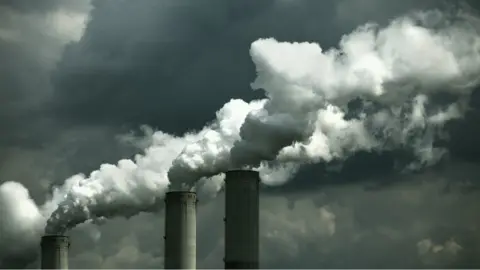 Getty Images
Getty ImagesGlobal efforts to tackle climate change are way off track says the UN, as it details the first rise in CO2 emissions in four years.
The emissions gap report says that economic growth is responsible for a rise in 2017 while national efforts to cut carbon have faltered.
To meet the goals of the Paris climate pact, the study says it's crucial that global emissions peak by 2020.
But the analysis says that this is now not likely even by 2030.
The report comes days before a major UN climate conference starting in Poland from 2-14 December.
What is the emissions gap?
For the last nine years, UN Environment have produced an assessment of the latest scientific studies on current and future emissions of greenhouse gases.
It highlights the difference between the level of greenhouse gas emissions that the world can sustain to keep temperatures within safe limits, with the levels that are likely based on the promises and actions taken by countries.
This year's report records the largest gap yet between where we are and where we need to be.


Why are emissions rising again?
Between 2014 and 2016, global emissions of CO2 from industry and the production of energy were essentially stable while the global economy grew modestly - but in 2017 these emissions went up by 1.2% pushed along by higher GDP.
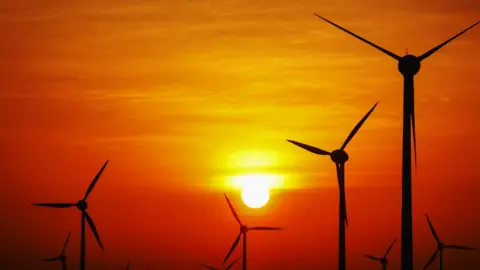 Getty Images
Getty ImagesWhile the rise might seem small, it needs to be seen in context of efforts to keep global temperatures from rising by more than 1.5C, as recently outlined in a key IPCC report.
According to the UN, to keep the world below that target, global greenhouse gas emissions in 2030 would have to be 55% lower than today.
"There is still a tremendous gap between words and deeds, between the targets agreed by governments worldwide to stabilise our climate and the measures to achieve these goals," said Dr Gunnar Luderer, from the Potsdam Institute for Climate Impact Research and one of the authors of the study.
The scientists say that to tackle the gap, nations must raise their ambition five fold to meet the 1.5C goal.
Right now, the world is heading for a temperature rise of 3.2C by the end of this century the report says.
No peaking?
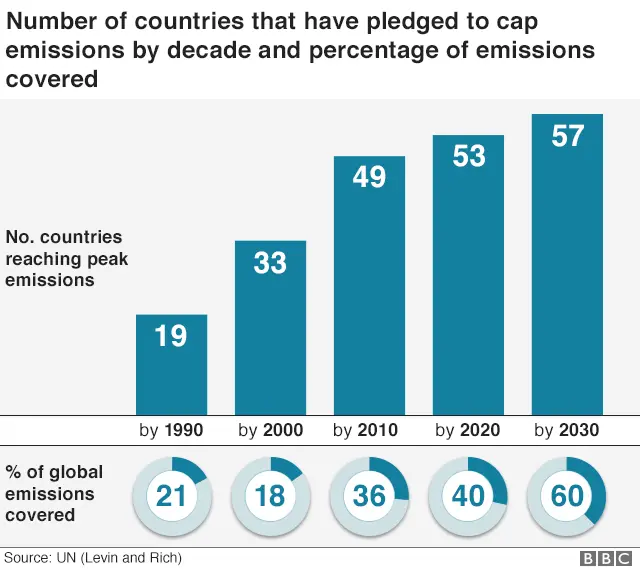
One key aspect of the study is about the peaking of global greenhouse emissions.
The report says that peaking of emissions in 2020 is "crucial for achieving the temperature targets in the Paris agreement," but the scale of the current efforts is insufficient.
The study says that by 2030, around 57 countries representing about 60% of global emissions will have peaked. Nowhere near where the world needs to be.
Does the report point the finger at countries that are doing badly?
In some ways yes. The study says that countries including Argentina, Australia, Canada, the EU (including the UK), South Korea, Saudi Arabia, South Africa and the US, are falling short of achieving their nationally determined contributions for 2030.
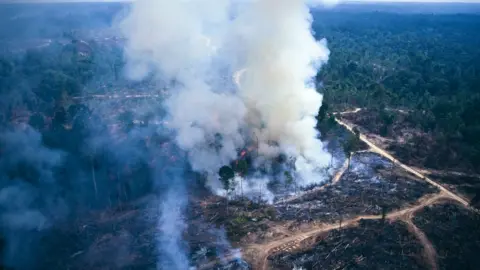 Getty Images
Getty ImagesThree countries, Brazil, China and Japan are currently on track, while three others, India, Russia and Turkey are set to beat their targets.
The authors believe that some of these achievements may be down to setting relatively low targets for their national plans.
Is there any positive news in the report?
Undoubtedly, yes.
The UN is placing great hopes in what it terms "non-state actors", meaning local, city and regional governments, businesses and higher education institutions can have major impacts on the future gap.
They estimate that, right now, more than 7,000 cities from 133 countries and 6,000 companies with at least $36 trillion in revenue have pledged to take climate action.
But the authors believe this is just scratching the surface. With over 500,000 publicly traded companies worldwide, there are many more that can take steps that cumulatively would have a significant impact on the gap.
The study says that there is the potential to cut emissions from this sector by 19 gigatonnes of CO2 equivalent per year by 2030 - that's enough to keep the world on a 2 degree path.
The future is fiscal?
The report also suggests that government tax plans could be hugely important in tackling emissions.
It says that carbon taxes or carbon trading systems cover only 15% of the global carbon output, which could rise to 20% if China implements its planned market. But the report says that half of the emissions from fossil fuels are not taxed at all and only 10% are priced at a level consistent with keeping warming to 2C.
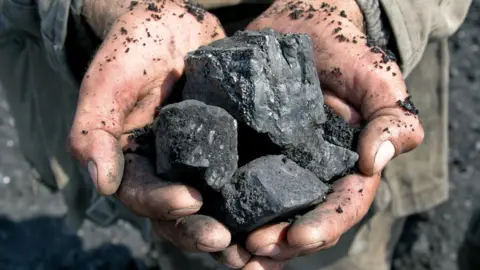 Getty Images
Getty Images"When governments embrace fiscal policy measures to subsidise low-emission alternatives and tax fossil fuels, they can stimulate the right investments in the energy sector and significantly reduce carbon emissions," said Jian Liu, UN Environment's chief scientist.
"If all fossil fuel subsidies were phased out, global carbon emissions could be reduced by up to 10% by 2030. Setting the right carbon price is also essential. At $70 per tonne of CO2, emission reductions of up to 40% are possible in some countries."
What happens now?
This report is aimed at informing delegates to next week's key climate conference in Katowice, Poland. Negotiators will be trying to finish the rules on how to implement the rule book of the Paris agreement - but the report's authors hope it can push countries to greater levels of ambition.
"Germany and Europe could demonstrate leadership in this area by pledging complete greenhouse gas neutrality by 2050 and a clear strengthening of the emission reduction targets for 2030," said Dr Gunnar Luderer.
